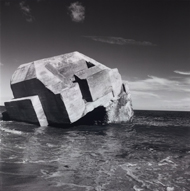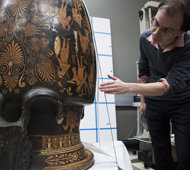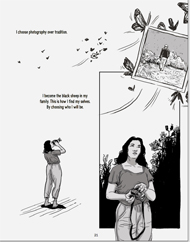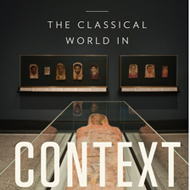NEW TO THE COLLECTION
| |
 The Borghese-Windsor Cabinet. Cabinet, about 1620, Italian (Rome); stand, before 1821, French. The J. Paul Getty Museum
The Borghese-Windsor Cabinet. Cabinet, about 1620, Italian (Rome); stand, before 1821, French. The J. Paul Getty Museum
|
The Borghese-Windsor Cabinet
Once in the collection of Pope Paul V Borghese and later acquired by King George IV of England, this
exquisite cabinet is exceptional its large size and sumptuous decoration. Expensive and difficult to cut and polish, the numerous hard stones (
pietre dure in Italian) covering the front in elaborate geometrical and chromatic patterns demonstrate the rarity of this piece. The statuettes with draperies in gilt bronze and with heads, hands, and legs in silver, add to its luxuriousness. The work is now on view in the East Pavilion at the
Getty Center.
In this
video introducing the work, curator Anne-Lise Demas identifies many fascinating details and reveals hidden compartments!
Watch now »
Getty Villa Reinstallation
The Classical World in Context
A new initiative at the
Getty Villa, launching in 2018, aims to present "Classical" objects in a broader historical and cultural context by illustrating the relationships between Greece, Rome, and the other great civilizations of their time, such as Egypt, Persia, and India.
Read story »
Also exploring this theme was the recent panel discussion
What Can the Ancient World Teach Us About Globalization?, presented with Zócalo Public Square, featuring New York University classics scholar Roger Bagnall, UC Santa Barbara sociologist and global studies scholar Jan Nederveen Pieterse, and Stanford classical philologist Grant Parker.
Listen to the discussion on soundcloud »
Explore Zócalo's Takeaway article »
ARTIST INTERVIEW
| |
 Casemate H667, 2006, Jane and Louise Wilson. Face-mounted chromogenic print. Courtesy of Gregory Keever. © Jane and Louise Wilson 2006
Casemate H667, 2006, Jane and Louise Wilson. Face-mounted chromogenic print. Courtesy of Gregory Keever. © Jane and Louise Wilson 2006
|
Jane and Louise Wilson
NEW ONLINE RESOURCE
| |
 Antiquities curator David Saunders examines the Altamura Krater.
Antiquities curator David Saunders examines the Altamura Krater.
|
Getty Around the World
PUBLICATION
| |
 An illustration from Photographic: The Life of Graciela Iturbide
An illustration from Photographic: The Life of Graciela Iturbide
|
Graphic Novel in Progress
The life of Mexican photographer
Graciela Iturbide (b. 1942) is being made into a graphic novel for young adults, the Getty's first foray into this genre. Iturbide began studying photography in 1970, under Manuel Álvarez Bravo. Her black-and-white images capture everyday life in Mexico, often focusing on its indigenous people with particular interest in the lives of women.
Photographic: The Life of Graciela Iturbide will be released in September to coincide with the launch of the Getty-led initiative
Pacific Standard Time: LA/LA—a region-wide exploration of Latin American and Latino art in dialogue with Los Angeles.
Read more »
Also published by the Getty »
Graciela Iturbide: Juchitán
PLANNING AHEAD
Getty360 Calendar
CONNECT WITH US
Follow us, learn about what we do, and tell us about your visit!
CONTACT US
General inquiries: visitorservices@getty.edu
Press inquiries: communications@getty.edu or visit our Press Room
Getty Museum News feedback: gettymuseumnews@getty.edu
The Getty Villa
17985 Pacific Coast Highway
Pacific Palisades, CA 90272
(310) 440-7300
Hours:
Weds–Mon: 10 a.m.–5 p.m., Closed Tuesdays
Admission to the Getty Villa is FREE. An advance, timed-entry ticket is required. Parking is $15, but $10 for evening events after 5:00 p.m.
Plan your visit
The Getty Center
1200 Getty Center Drive
Los Angeles, CA 90049
(310) 440-7300
Hours:
Tues–Fri and Sun: 10 a.m.–5:30 p.m.
Sat: 10 a.m.–9 p.m., Closed Mondays
Admission to the Getty Center is FREE. Parking is $15, but $10 after 5:00 p.m. for Saturday evening hours and for evening events.
Plan your visit
 The Borghese-Windsor Cabinet. Cabinet, about 1620, Italian (Rome); stand, before 1821, French. The J. Paul Getty Museum
The Borghese-Windsor Cabinet. Cabinet, about 1620, Italian (Rome); stand, before 1821, French. The J. Paul Getty Museum








